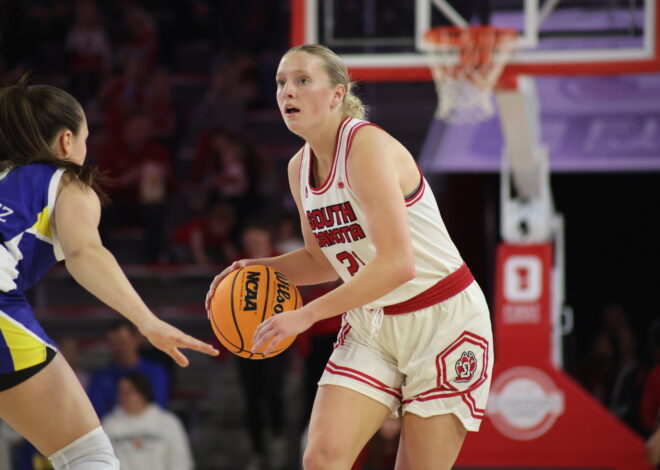A yearly ordeal takes place for contracts
For college coaches, single-year contracts can display a lack of support and an unknown future.
However, in South Dakota, that is all coaches can receive.
Appropriation policies in South Dakota make it so a one-year contract is all that can be guaranteed to coaches, as well as educational positions.
This leaves the state’s two Division-I schools, the University of South Dakota and South Dakota State University, only able to promise one year contracts to their athletic leaders, while their competitors, whether in conference or out of conference, are able to sign multi-year deals.
Glenn said the status of Division I calls upon the state to revise this policy.
“It’s not our school’s policy; it’s the state’s,” Glenn said. “I don’t know why we couldn’t give a guy a three-year contract — other schools in our division are doing it. I think our state would want to compete. We’re at this level now, and our legislature and state representatives should recognize that.”
Jim Shekleton, of the S.D. Board of Regents, said it is technically possible for the state’s universities to sign multi-year contracts, but it is rarely practiced.
“The employment contracts are paid from the general appropriations fund,” Shekleton said. “The appropriations are paid year by year. It is possible to write a contract that could cover future appropriations, but it has to be with the condition subsequent. In theory it would be possible to do that, but in practice it hasn’t been done.”
These rules go for all government employees, Shekleton said, including teachers and even USD president Jim Abbott. While in theory this could be done, S.D. Legislature would have to approve the appropriations for multiple years come January.
Abbott said while a three-year contract can be written, there is nothing guaranteed.
“If the legislature said that they don’t like three contracts, then they could easily refuse to appropriate the money when the legislature meets to approve the budget for the following year,” Abbott said. “So in theory, salaries are only approved for a year.”
This leaves South Dakota universities behind the curve compared to other regional universities, including Nebraska, Iowa, Minnesota and North Dakota.
USD Athletic Director David Herbster said when the newest coaches were hired, there was an understanding from the beginning of the one-year contract standard.
“We were fortunate when we hired (Glenn) that we were hiring an alumni to come back and he was not concerned about a multi-year contract,” Herbster said. “We were also fortunate that when we hired (head women’s basketball coach) Amy Williams. She understood what we were up against here in South Dakota.”
While both the football and women’s basketball vacancies were filled fairly easily because of the trust from the university, Herbster said a problem might surface when trying to fill the men’s basketball position.
“Our (men’s) basketball coach — that will be the one that will be the test,” Herbster said. “Joey (James) has been in our system for a long time and understands that there are no multi-year contracts. However, if we bring in somebody from the outside my feeling is that this will affect the candidate pool.”
Abbott said he brings up the one year rule before he hires anyone at the university, but does well to ensure as much stability as he can.
“All coaches are labeled as non-faculty exempt position,” Abbott said. “They are not guaranteed employment except for that year. I make it very clear that if I am hiring someone, I can only give them a one year contract. But I promise you that unless something happens completely outside the realm of what’s reasonable, you may expect to continue your employment.”
James said he thought the practice would be changed while the school was going through the process of transferring to Division I.
“I thought personally it would change once we made the transition into Division I,” James said. “It hasn’t yet, but it needs to. It’s one of the more important things we need to do besides the arena.”
While these rules particularly hurt the university and its potential coaches, the rules can also affect the players and the potential recruits.
Sophomore football player Keyen Lage said he believes the lack of stability could affect the university.
“When a kid comes in he wants to have a coach he loves, and he loves playing for, and he wants to play for him for four years,” Lage said. “So hearing that a coach could only be there for potentially one year, that really kills the vibe of wanting to go to that school, because every kid coming in is looking for stability.”
Lage was recruited under former head football coach Ed Meierkort and witnessed the coaching change to Glenn in December 2011.
“I really liked my recruiting coach at the time, Adam Breske,” Lage said. “When I found out that he was staying for sure, after Glenn got hired, I knew USD was right.”
Herbster said he believes every school in the region, including every South Dakota school, should be on a multi-year deal because of the ways it helps recruiting.
“We should all be on multi-year contracts,” Herbster said. “It allows you to bring in the best candidates and provides stability and certainty for your coaching staffs. You want to be able to go into a recruit’s living room and say, ‘I’m on a multi-year contract, and they’re committed to me.’”
Abbott said there has been minor talk about reversing this rule.
“There has been talk about multi-year contracts, but I suspect that in a higher-education system that it would seem inappropriate to some citizens and some legislators to move to have coaches have multi-year contracts and not teachers,” Abbott said.

